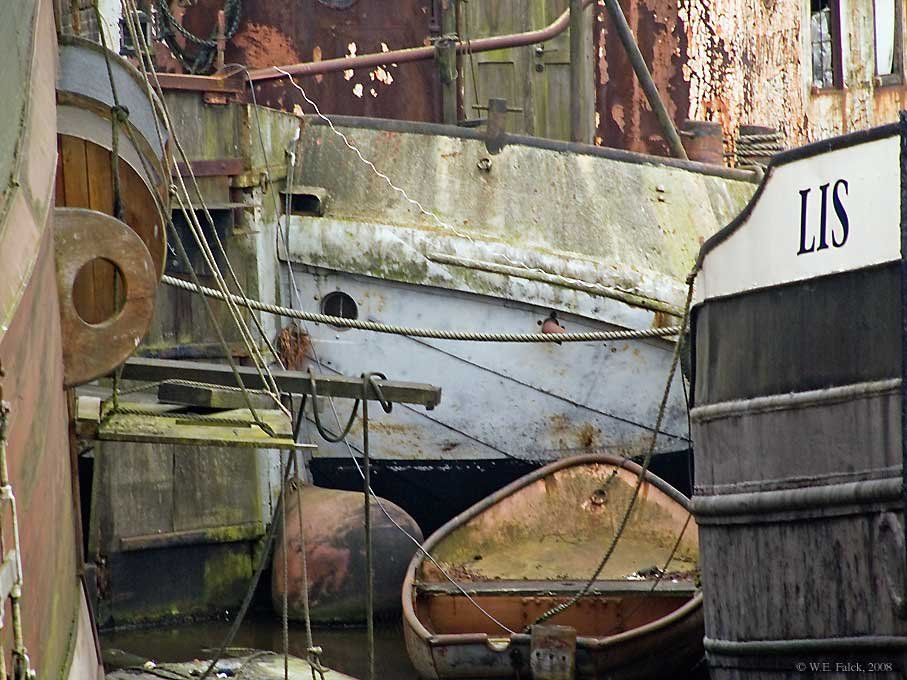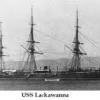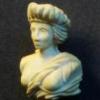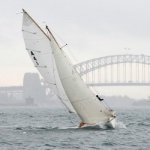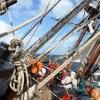-
Posts
6,521 -
Joined
-
Last visited
Reputation Activity
-
 wefalck reacted to Dr PR in USS Cape (MSI-2) by Dr PR - 1:48 - Inshore Minesweeper
wefalck reacted to Dr PR in USS Cape (MSI-2) by Dr PR - 1:48 - Inshore Minesweeper
Keith,
The explosions behind you aren't your concern. You want to watch for things in front of you that might blow you out of the water!
Here are some more details. This time it is the life rings.
The life rings were 24 inch diameter, and that comes out to half an inch (12.7 mm) at 1:48 scale. I looked through all the materials I have on hand and I could cut them from some 3/8 inch thick boxwood, or from some basswood sheets. But cutting from wood created the distinct possibility that it would break along the grain during the shaping process. It would be easier to cut them from a half inch dowel, but I didn't have any in stock. The only thing that diameter was some clear acrylic (Plexiglas) tubing. However, the walls weren't thick enough. But I did have some white styrene tubing that was a tight press fit into the acrylic and had an inside diameter a bit smaller (0.25 inch/6.35 mm) than the inside diameter of the life rings. Acrylic and styrene are easy to work, so I decided to use that combination.
I sawed slices off the end of the concentric tubes and then filed/sanded them into the right thickness (0.073 inch/1.85 mm). I fit these rings over a 1/4 inch brass tube chucked into a drill and used files to round the outer edges. Then a combination of tools were used to round the inside edges and bring the opening up to the desired 0.275 inch/7 mm diameter. After they were painted orange I wrapped some carpet thread to make the ropes. Then three "J" hooks were made for each to attach them to the deck house sides.
The white cylinders beside the rings are light floats. When they are positioned with the flat base upward the lights are disabled. In the water the flat base is heavier (batteries) than the top so it floats with the conical light on top and the light is turned on. The light makes it easier to find the life ring in the dark.
I have added the pilot house doors and some other details. On the real ship the life rings were painted with "USS" in the top quadrant, "CAPE" on the bottom. "MSI" marked vertically on the left side and "TWO" vertically on the right. These letters would be only 0.010 to 0.015 inch (0.25 to 0.38 mm) high at 1:48 scale so I decided to not try to make them.
Here is a close up of the port bridge wing with the pilot house door, pelorus, life ring and ladder to the O2 level installed. This completes the open bridge and pilot house side details.
I guess the next work will be the venturis along the top of the bridge bulwarks and the port and starboard side lights. I still haven't decided how to make the venturis.
I might work on some other details on the aft end of the O1 level, including the funnel. I also need to add the life rails around the O2 level and on the after end of the O1 level. And there are the windows and awnings on the front of the bridge bulwarks. All of these will be very delicate and will be saved for the last work on the deck houses.
Here are a couple more photos of the open bridge and pilot house.
-
 wefalck got a reaction from mcb in Pomeranian Rahschlup 1846 by wefalck – 1/160 scale – single-masted Baltic trading vessel
wefalck got a reaction from mcb in Pomeranian Rahschlup 1846 by wefalck – 1/160 scale – single-masted Baltic trading vessel
Thanks again to all for their encouragement !
**********************************************
Some small progress in the true and literary sense of the word:
Bilge-pump
Although not drawn in the original drawings, the ship must have had at least one bilge-pump. Such pumps would be logically located at the lowest part of the hull, usually somewhere close to the mast. As its location is not marked on the drawings, this is a bit of guess-work.
While Downton-pumps or similar existed already, when the Rahschlup was designed, they were comparatively expensive items. As the ship was built in a rather economically marginal context, it is more likely that a traditional wooden pump was installed, that could also be built and maintained with local materials and by local craftsmen, such as a blacksmith. Nicely rendered drawings for such pumps can be found, for instance, in the Danish naval yard archive.
Example for a bilge-pump from the former Danish naval yard (extract from G-2357-09)
The trunk would have been fashioned from a single tree, typically elm, that was bored out with the aid of spoon- or canon-drills in a sort of primitive boring-lathe. Iron bands kept it together and served as attachment points for the lever.
https://youtu.be/pj-XKqW29XE?si=9Q8RTsXOMxMuPPVN
Example for drilling of wooden pipes.
I made a rough sketch to fix the dimensions and settled on a height of 4 mm and a diameter of 1 mm, which would be 64 cm and 16 cm on the original respectively. The body was turned from a short length of acrylic rod, leaving the future bands as proud rings.
The mechanism is composed of four lengths of 0.2 mm tinned copper wire. The wire was first bent to shape and flattened at the appropriate places with a special kind of flattening pliers. Initially, I intended to solder the parts together, but they were just too small and flimsy, so I settled on cementing them together with lacquer. The procedure is a bit difficult to document photographically while doing it, so there are only pictures of the finished product.
The completed bilge-pump
I am afraid the translucent pump does not show very well in the photograph, but I generally only paint everything at the very end to avoid damage during repeated handling.
To be continued …
-
 wefalck got a reaction from Ryland Craze in Billy 1938 by Keith Black - 1:120 Scale - Homemade Sternwheeler
wefalck got a reaction from Ryland Craze in Billy 1938 by Keith Black - 1:120 Scale - Homemade Sternwheeler
I think I said something like that before, but I love those 'shanty-boats' (as in shanty-towns), these improvised thingies of a kind, one would have rarely seen anymore in regulated early 20th century Europe.
It also shows a kind of live that has largely disappeared since the 1950s, where whole families were living on workboats and where husband and wife (and possibly children) shared the work.
-
 wefalck got a reaction from Canute in Billy 1938 by Keith Black - 1:120 Scale - Homemade Sternwheeler
wefalck got a reaction from Canute in Billy 1938 by Keith Black - 1:120 Scale - Homemade Sternwheeler
I think I said something like that before, but I love those 'shanty-boats' (as in shanty-towns), these improvised thingies of a kind, one would have rarely seen anymore in regulated early 20th century Europe.
It also shows a kind of live that has largely disappeared since the 1950s, where whole families were living on workboats and where husband and wife (and possibly children) shared the work.
-
 wefalck reacted to Lecrenb in St Roch by Lecrenb - 1:48 scale - RCMP Schooner rigged as schooner c. 1930/35
wefalck reacted to Lecrenb in St Roch by Lecrenb - 1:48 scale - RCMP Schooner rigged as schooner c. 1930/35
Running rigging at the forward end of St. Roch is now complete, and work continues to prefab the shrouds and stays...
The previous picture shows the back stays being built together on a template that I made on my silkspan frame.
This picture shows the stays finished and the shrouds started.
This is a clearer shot of the template... the jib sheets (ready for paint) are also seen in this picture.
The template started out as one line for the back stays, with the insulator locations marked. Holes are drilled for pins to hold the turn buckle, insulators, and at the top eye location. The two stays already made are shown, ready to be installed.
Then I added the second line to make the shroud template, moving the insulator and eye locations, and indicating where the ratlines (which are wooden slats) will go.
Here is the shroud partially made...
Note the running light will also be fastened to the shroud. Once the shrouds are completed I will adjust the top end of the template for the longer stays and shrouds required for the main mast. Thus the template evolves while the lower end turnbuckles remain constant and properly spaced.
Moving on, the jib sheets got installed... consultation with my museum contact and sailor friend was required, since photos do not show them rigged to the clew while the sail is furled. Consensus is that they were still rigged on the ship and not stowed away, so they would be handy if the sails needed to be set. I accordingly belayed the ends to the pin rails just aft of the fo'c's'le break, and mounted the blocks to rings on the cap rail as shown on the rigging plan. They may have been mounted lower down, on the staghorns, but there is no consensus for this, so I went with the plan. The horns may have been used to belay the running end of the sheet when in use, again, not sure, but makes sense...
I ran the sheets out to a pair of rings near the bow. Whether or not these were installed for this purpose I do not know, but their presence was too convenient to ignore, so the jib sheets were hooked to them. This arrangement keeps the rigging from fouling the deck while being ready to bend onto the sail.
Here is the port side jib sheet...
The next picture shows the starboard jib sheet, and the foresail sheet as well.
This last picture is a clearer shot of the foresail sheet, which was made up on the model after the blocks were prepared and painted.
The boom is posed over to port to allow the cargo handling to be shown. I wasn't sure what to do with the extra line, since there was no obvious place for it, so I placed the coil between the cleat and the horse... I could move it if a better option presents itself, we'll see.
That's it for now, back to the foremast shrouds... once the standing rigging is on the foremast I will repeat everything done over the last few weeks on the main mast.
Regards,
Bruce
-
 wefalck got a reaction from Keith Black in Billy 1938 by Keith Black - 1:120 Scale - Homemade Sternwheeler
wefalck got a reaction from Keith Black in Billy 1938 by Keith Black - 1:120 Scale - Homemade Sternwheeler
I think I said something like that before, but I love those 'shanty-boats' (as in shanty-towns), these improvised thingies of a kind, one would have rarely seen anymore in regulated early 20th century Europe.
It also shows a kind of live that has largely disappeared since the 1950s, where whole families were living on workboats and where husband and wife (and possibly children) shared the work.
-
 wefalck got a reaction from Cathead in Billy 1938 by Keith Black - 1:120 Scale - Homemade Sternwheeler
wefalck got a reaction from Cathead in Billy 1938 by Keith Black - 1:120 Scale - Homemade Sternwheeler
I think I said something like that before, but I love those 'shanty-boats' (as in shanty-towns), these improvised thingies of a kind, one would have rarely seen anymore in regulated early 20th century Europe.
It also shows a kind of live that has largely disappeared since the 1950s, where whole families were living on workboats and where husband and wife (and possibly children) shared the work.
-
 wefalck reacted to Keith Black in Billy 1938 by Keith Black - 1:120 Scale - Homemade Sternwheeler
wefalck reacted to Keith Black in Billy 1938 by Keith Black - 1:120 Scale - Homemade Sternwheeler
Thank you to everyone for the comments and likes.
The port side wall is built and painted.
I bashed a six pane window to make the two over one window, added glazing and a shade per Billy's photo. I guessed at the colors the best I could by studying the press photo Weathering will do wonders but I'll wait till Billy is completed.
Billy is going to be colorful.
Thank you for your support and for following along.
Keith
-
 wefalck reacted to Keith Black in Billy 1938 by Keith Black - 1:120 Scale - Homemade Sternwheeler
wefalck reacted to Keith Black in Billy 1938 by Keith Black - 1:120 Scale - Homemade Sternwheeler
Thank you to everyone for the likes and support. And a very special thank you for all the comments. I know words aren't necessarily as exciting as sawdust but your comments helped me immensely. If I'm unsure about a thing when I go to build it I usually make a dog's lunch of it. Being confident that the center stairway was the correct approach (which I wouldn't have been if not for the discussion on the subject) gave me the freedom to put my heart into making the hull.
Speaking of the hull, it's done and ready for me to start the deck structures.
Size perspective.
The raised portions represent the floor joist band boards.
Thank you so much for your willingness to share in the journey.
Keith
-
 wefalck reacted to J Snyder in Gary Thomas by J Snyder - 1:16 - William Atkin 25 foot Sloop
wefalck reacted to J Snyder in Gary Thomas by J Snyder - 1:16 - William Atkin 25 foot Sloop
I am starting on my first scratch build of the boat I helped build as a student at a boat building school near Fort Bragg, California in the 70s.
I have some mulberry wood that I am using for the stem, keel and deadwood. It has pronounced grain but is free and available. I haven't decided on the level of detail for this first scratch build. I built a thickness sander attachment for my drill press to get the lumber down to size and got started.
Gary Thomas Sail plan.pdf
-
 wefalck got a reaction from KeithAug in SMS WESPE 1876 by wefalck – FINISHED - 1/160 scale - Armored Gunboat of the Imperial German Navy - as first commissioned
wefalck got a reaction from KeithAug in SMS WESPE 1876 by wefalck – FINISHED - 1/160 scale - Armored Gunboat of the Imperial German Navy - as first commissioned
A few glamour-shots of S.M.S. WESPE
Finally, I managed to go into town to buy a suitable paper as backdrop for the glamour-shots of the whole model. Here they are without further comments:
And also two shots in black & white:
-
 wefalck reacted to Mark Pearse in Ranger type yacht by Mark Pearse - 1:12 - SMALL
wefalck reacted to Mark Pearse in Ranger type yacht by Mark Pearse - 1:12 - SMALL
Hi Craig, thanks for the compliment, it worked out nicely. Re the loss of thrust, I suppose they factor a bit of extra blade area in when selecting the appropriate diameter & pitch etc. Another option is solved in another way by a local traditional sailing type, that are restricted to fixed props (ie: no feathering allowed), they use 2 bladed & put a spot of paint on the shaft so they can align the 2 blades vertically, so the blades sit behind the deadwood.
-
 wefalck got a reaction from archjofo in Pomeranian Rahschlup 1846 by wefalck – 1/160 scale – single-masted Baltic trading vessel
wefalck got a reaction from archjofo in Pomeranian Rahschlup 1846 by wefalck – 1/160 scale – single-masted Baltic trading vessel
Thanks again to all for their encouragement !
**********************************************
Some small progress in the true and literary sense of the word:
Bilge-pump
Although not drawn in the original drawings, the ship must have had at least one bilge-pump. Such pumps would be logically located at the lowest part of the hull, usually somewhere close to the mast. As its location is not marked on the drawings, this is a bit of guess-work.
While Downton-pumps or similar existed already, when the Rahschlup was designed, they were comparatively expensive items. As the ship was built in a rather economically marginal context, it is more likely that a traditional wooden pump was installed, that could also be built and maintained with local materials and by local craftsmen, such as a blacksmith. Nicely rendered drawings for such pumps can be found, for instance, in the Danish naval yard archive.
Example for a bilge-pump from the former Danish naval yard (extract from G-2357-09)
The trunk would have been fashioned from a single tree, typically elm, that was bored out with the aid of spoon- or canon-drills in a sort of primitive boring-lathe. Iron bands kept it together and served as attachment points for the lever.
https://youtu.be/pj-XKqW29XE?si=9Q8RTsXOMxMuPPVN
Example for drilling of wooden pipes.
I made a rough sketch to fix the dimensions and settled on a height of 4 mm and a diameter of 1 mm, which would be 64 cm and 16 cm on the original respectively. The body was turned from a short length of acrylic rod, leaving the future bands as proud rings.
The mechanism is composed of four lengths of 0.2 mm tinned copper wire. The wire was first bent to shape and flattened at the appropriate places with a special kind of flattening pliers. Initially, I intended to solder the parts together, but they were just too small and flimsy, so I settled on cementing them together with lacquer. The procedure is a bit difficult to document photographically while doing it, so there are only pictures of the finished product.
The completed bilge-pump
I am afraid the translucent pump does not show very well in the photograph, but I generally only paint everything at the very end to avoid damage during repeated handling.
To be continued …
-
 wefalck reacted to Mark Pearse in Ranger type yacht by Mark Pearse - 1:12 - SMALL
wefalck reacted to Mark Pearse in Ranger type yacht by Mark Pearse - 1:12 - SMALL
The propeller is a feathering one, & that makes it a bit easier to fabricate accurately, as the blades don't have twist. I think the way they work is that the prop shaft always turns the same direction, but when the engage reverse the blade angle rotates from the 'forwards' position to the 'reverse' position & so opposite thrust for same shaft rotation direction. Incredible pieces of engineering, if you ever get to see inside of one.....
Here's the prop itself, with anode at the end & blades feathered:
First, the main body of the prop is made from 6mm brass rod, drilled first to take the shaft & then tapered (bow end) by using a drill & rubbing the rod against a file, then sandpaper:
The the anode shape was done, & the step using a broken piece of craft knife blade, against the spinning rod:
The blades are from 1.5mm thick sheet, cut with a jewellers saw & the sanded to fine edges but full thickness where the blades meet the shaft. Soldered to the shaft:
And cleaned up, & installed temporarily (nb: there will need to be a small washer where the shaft penetrates the keel).
-
 wefalck reacted to Cathead in Missouri, Kansas, & Texas Railroad along the Missouri River by Cathead - 1/87 (HO) scale - model railroad with steamboat
wefalck reacted to Cathead in Missouri, Kansas, & Texas Railroad along the Missouri River by Cathead - 1/87 (HO) scale - model railroad with steamboat
OK, here's a fun little mini-building project. A few years ago, the official newsletter of the Katy Railroad Historical Society had a modeler's article on building a simple railroad coal shed. These were used by the Katy to store coal for use in stoves/furnaces within small railroad buildings like depots, offices, or workshops. Like most railroads, there were official designs for exactly how to build these, so the article shared blueprints and an example of a model built in 1:48 scale (larger than my 1:87 scale).
These would be located along a spur, where a gondola of coal would be spotted. Coal would then be shoveled into the hatch in the back, filling the shed. When coal was needed, a worker could open the front door and shovel it out. This had upper and lower halves for obvious reasons.
I decided that one of these would be the perfect addition to my version of Rocheport, since the depot has a stove. A coal shed isn't clearly visible in the photos I have, but I decided I don't care. It's another place to spot a car, adding operational interest, and it nicely fills in an empty zone near the depot, a place you can see several sheds (just not a coal shed like this one).
Here are the four walls laid out, using scribed siding and extra strips for the outside bracing. Figure for scale.
Assembling the walls with a magnetic jig:
Walls, roof, and floor assemblies, with the thick beams the whole structure rests on. These are stained cherry, scraps left over from my NRG capstan and other projects:
Painted in the proper corporate yellow/green scheme (same as depot), assembled, and weathered, with tarpaper roof (front and back views):
While I was at it, I built a small outhouse to go nearby as these depots didn't have indoor plumbing in this era:
And here are the final two buildings on the article photo:
Here they are installed on the layout. I'm pretty amused at the genius of placing the outhouse right across the tracks from the stockyard:
I like how these extend the "railroad property" zone a bit to the east (right) with their coloring.
And here's the classic historical photo showing a few sheds east of the depot; I'm just shifting their exact location and purpose to suit my needs, as most model railroaders do:
This was a fun couple nights of work and fills in another small spot on the layout. I've been doing some scenery work, too, but am not ready to share it. This, at least, shows you that I've been doing something!
Thanks for following along.
-
 wefalck got a reaction from Ras Ambrioso in Pomeranian Rahschlup 1846 by wefalck – 1/160 scale – single-masted Baltic trading vessel
wefalck got a reaction from Ras Ambrioso in Pomeranian Rahschlup 1846 by wefalck – 1/160 scale – single-masted Baltic trading vessel
Thanks again to all for their encouragement !
**********************************************
Some small progress in the true and literary sense of the word:
Bilge-pump
Although not drawn in the original drawings, the ship must have had at least one bilge-pump. Such pumps would be logically located at the lowest part of the hull, usually somewhere close to the mast. As its location is not marked on the drawings, this is a bit of guess-work.
While Downton-pumps or similar existed already, when the Rahschlup was designed, they were comparatively expensive items. As the ship was built in a rather economically marginal context, it is more likely that a traditional wooden pump was installed, that could also be built and maintained with local materials and by local craftsmen, such as a blacksmith. Nicely rendered drawings for such pumps can be found, for instance, in the Danish naval yard archive.
Example for a bilge-pump from the former Danish naval yard (extract from G-2357-09)
The trunk would have been fashioned from a single tree, typically elm, that was bored out with the aid of spoon- or canon-drills in a sort of primitive boring-lathe. Iron bands kept it together and served as attachment points for the lever.
https://youtu.be/pj-XKqW29XE?si=9Q8RTsXOMxMuPPVN
Example for drilling of wooden pipes.
I made a rough sketch to fix the dimensions and settled on a height of 4 mm and a diameter of 1 mm, which would be 64 cm and 16 cm on the original respectively. The body was turned from a short length of acrylic rod, leaving the future bands as proud rings.
The mechanism is composed of four lengths of 0.2 mm tinned copper wire. The wire was first bent to shape and flattened at the appropriate places with a special kind of flattening pliers. Initially, I intended to solder the parts together, but they were just too small and flimsy, so I settled on cementing them together with lacquer. The procedure is a bit difficult to document photographically while doing it, so there are only pictures of the finished product.
The completed bilge-pump
I am afraid the translucent pump does not show very well in the photograph, but I generally only paint everything at the very end to avoid damage during repeated handling.
To be continued …
-
 wefalck reacted to JacquesCousteau in Bateau de Lanvéoc by JacquesCousteau - Scale 1:32 - From Ancre Plans
wefalck reacted to JacquesCousteau in Bateau de Lanvéoc by JacquesCousteau - Scale 1:32 - From Ancre Plans
Thanks all! Just to be clear, we got married a while ago (legal paperwork a few years ago, ceremony and celebration this past summer), our honeymoon was just delayed quite a bit.
-
 wefalck got a reaction from druxey in Ranger type yacht by Mark Pearse - 1:12 - SMALL
wefalck got a reaction from druxey in Ranger type yacht by Mark Pearse - 1:12 - SMALL
If you make the metal-work in brass, instead of painting, you could also look into self-tinning solution. Over here in Europe some model-shops carry it, but otherwise it can be found in electronics supply shops - nothing looks like metal - like metal
-
 wefalck reacted to Mark Pearse in Ranger type yacht by Mark Pearse - 1:12 - SMALL
wefalck reacted to Mark Pearse in Ranger type yacht by Mark Pearse - 1:12 - SMALL
Thanks all,
As the base will be a scaled section of a boatyard hardstand area, the supports for the model will also replicate a type used at a boatyard. The model hull supports will be 4 of the pedestal supports, & under the keel will be some blocks of timber. This photo shows the supports I'm making, the original yellow is just visible below the accretion of paint on this one:
And the swivel head fitting:
Mine are from brass solid rod, 2.5, 3 & 4mm diameter. The actual ones are pretty rough, so the workmanship on mine is a bit rough as well. The solder looks a bit like thick, unground welds, so I left some thick solder on the joints. The angled struts are also drilled on the underside of the feet, & perpendicular to the base, so I can glue or solder some 1.5mm rods into the base to make sure they all stay securely fixed to the base. Seen here in approximate position:
And here, with the adjustment fitting....and I just realised I need to do the flat plate cleats that take the chains, see the first photo above. You can also see the swivel head piece (below). I'm waiting on some 3mm brass threaded rod to complete them. There will be some fun with paint to come...
-
 wefalck reacted to JacquesCousteau in Bateau de Lanvéoc by JacquesCousteau - Scale 1:32 - From Ancre Plans
wefalck reacted to JacquesCousteau in Bateau de Lanvéoc by JacquesCousteau - Scale 1:32 - From Ancre Plans
Not a very exciting update. I was able to get a bit more fairing in today, and I think the hull is almost there. I think one more session focused on the starboard stern, and one last session for final fairing, should get me there.
While I'm happy with how the bow has turned out, I'm still not totally sure on the stern cant frames. I keep snapping battens trying to check. On the other hand, an already-bent bit of scrap seems to fit fairly well, and the plans do seem to show quite a curve there, so I think I'll just have to pre-bend the planking there.
In any case, it may be a while before I post updates. We'll be traveling for our honeymoon soon, then visiting family for Christmas. It may be January before I can finish fairing and finally start planking. In the meantime, I'll leave things off with the photo below, which I thought nicely showed the curve of the hull.
(It's funny that it automatically adds that it's AI-generated in the corner of the photo. To disclose: I used an editing tool to erase something from my desk at the top of the photo, not to generate the model.)
-
 wefalck got a reaction from Mark Pearse in Pomeranian Rahschlup 1846 by wefalck – 1/160 scale – single-masted Baltic trading vessel
wefalck got a reaction from Mark Pearse in Pomeranian Rahschlup 1846 by wefalck – 1/160 scale – single-masted Baltic trading vessel
Thanks again to all for their encouragement !
**********************************************
Some small progress in the true and literary sense of the word:
Bilge-pump
Although not drawn in the original drawings, the ship must have had at least one bilge-pump. Such pumps would be logically located at the lowest part of the hull, usually somewhere close to the mast. As its location is not marked on the drawings, this is a bit of guess-work.
While Downton-pumps or similar existed already, when the Rahschlup was designed, they were comparatively expensive items. As the ship was built in a rather economically marginal context, it is more likely that a traditional wooden pump was installed, that could also be built and maintained with local materials and by local craftsmen, such as a blacksmith. Nicely rendered drawings for such pumps can be found, for instance, in the Danish naval yard archive.
Example for a bilge-pump from the former Danish naval yard (extract from G-2357-09)
The trunk would have been fashioned from a single tree, typically elm, that was bored out with the aid of spoon- or canon-drills in a sort of primitive boring-lathe. Iron bands kept it together and served as attachment points for the lever.
https://youtu.be/pj-XKqW29XE?si=9Q8RTsXOMxMuPPVN
Example for drilling of wooden pipes.
I made a rough sketch to fix the dimensions and settled on a height of 4 mm and a diameter of 1 mm, which would be 64 cm and 16 cm on the original respectively. The body was turned from a short length of acrylic rod, leaving the future bands as proud rings.
The mechanism is composed of four lengths of 0.2 mm tinned copper wire. The wire was first bent to shape and flattened at the appropriate places with a special kind of flattening pliers. Initially, I intended to solder the parts together, but they were just too small and flimsy, so I settled on cementing them together with lacquer. The procedure is a bit difficult to document photographically while doing it, so there are only pictures of the finished product.
The completed bilge-pump
I am afraid the translucent pump does not show very well in the photograph, but I generally only paint everything at the very end to avoid damage during repeated handling.
To be continued …
-
 wefalck got a reaction from Doreltomin in Pomeranian Rahschlup 1846 by wefalck – 1/160 scale – single-masted Baltic trading vessel
wefalck got a reaction from Doreltomin in Pomeranian Rahschlup 1846 by wefalck – 1/160 scale – single-masted Baltic trading vessel
Thanks again to all for their encouragement !
**********************************************
Some small progress in the true and literary sense of the word:
Bilge-pump
Although not drawn in the original drawings, the ship must have had at least one bilge-pump. Such pumps would be logically located at the lowest part of the hull, usually somewhere close to the mast. As its location is not marked on the drawings, this is a bit of guess-work.
While Downton-pumps or similar existed already, when the Rahschlup was designed, they were comparatively expensive items. As the ship was built in a rather economically marginal context, it is more likely that a traditional wooden pump was installed, that could also be built and maintained with local materials and by local craftsmen, such as a blacksmith. Nicely rendered drawings for such pumps can be found, for instance, in the Danish naval yard archive.
Example for a bilge-pump from the former Danish naval yard (extract from G-2357-09)
The trunk would have been fashioned from a single tree, typically elm, that was bored out with the aid of spoon- or canon-drills in a sort of primitive boring-lathe. Iron bands kept it together and served as attachment points for the lever.
https://youtu.be/pj-XKqW29XE?si=9Q8RTsXOMxMuPPVN
Example for drilling of wooden pipes.
I made a rough sketch to fix the dimensions and settled on a height of 4 mm and a diameter of 1 mm, which would be 64 cm and 16 cm on the original respectively. The body was turned from a short length of acrylic rod, leaving the future bands as proud rings.
The mechanism is composed of four lengths of 0.2 mm tinned copper wire. The wire was first bent to shape and flattened at the appropriate places with a special kind of flattening pliers. Initially, I intended to solder the parts together, but they were just too small and flimsy, so I settled on cementing them together with lacquer. The procedure is a bit difficult to document photographically while doing it, so there are only pictures of the finished product.
The completed bilge-pump
I am afraid the translucent pump does not show very well in the photograph, but I generally only paint everything at the very end to avoid damage during repeated handling.
To be continued …
-
 wefalck got a reaction from Bedford in Pomeranian Rahschlup 1846 by wefalck – 1/160 scale – single-masted Baltic trading vessel
wefalck got a reaction from Bedford in Pomeranian Rahschlup 1846 by wefalck – 1/160 scale – single-masted Baltic trading vessel
Thanks again to all for their encouragement !
**********************************************
Some small progress in the true and literary sense of the word:
Bilge-pump
Although not drawn in the original drawings, the ship must have had at least one bilge-pump. Such pumps would be logically located at the lowest part of the hull, usually somewhere close to the mast. As its location is not marked on the drawings, this is a bit of guess-work.
While Downton-pumps or similar existed already, when the Rahschlup was designed, they were comparatively expensive items. As the ship was built in a rather economically marginal context, it is more likely that a traditional wooden pump was installed, that could also be built and maintained with local materials and by local craftsmen, such as a blacksmith. Nicely rendered drawings for such pumps can be found, for instance, in the Danish naval yard archive.
Example for a bilge-pump from the former Danish naval yard (extract from G-2357-09)
The trunk would have been fashioned from a single tree, typically elm, that was bored out with the aid of spoon- or canon-drills in a sort of primitive boring-lathe. Iron bands kept it together and served as attachment points for the lever.
https://youtu.be/pj-XKqW29XE?si=9Q8RTsXOMxMuPPVN
Example for drilling of wooden pipes.
I made a rough sketch to fix the dimensions and settled on a height of 4 mm and a diameter of 1 mm, which would be 64 cm and 16 cm on the original respectively. The body was turned from a short length of acrylic rod, leaving the future bands as proud rings.
The mechanism is composed of four lengths of 0.2 mm tinned copper wire. The wire was first bent to shape and flattened at the appropriate places with a special kind of flattening pliers. Initially, I intended to solder the parts together, but they were just too small and flimsy, so I settled on cementing them together with lacquer. The procedure is a bit difficult to document photographically while doing it, so there are only pictures of the finished product.
The completed bilge-pump
I am afraid the translucent pump does not show very well in the photograph, but I generally only paint everything at the very end to avoid damage during repeated handling.
To be continued …
-
 wefalck got a reaction from druxey in Pomeranian Rahschlup 1846 by wefalck – 1/160 scale – single-masted Baltic trading vessel
wefalck got a reaction from druxey in Pomeranian Rahschlup 1846 by wefalck – 1/160 scale – single-masted Baltic trading vessel
Thanks again to all for their encouragement !
**********************************************
Some small progress in the true and literary sense of the word:
Bilge-pump
Although not drawn in the original drawings, the ship must have had at least one bilge-pump. Such pumps would be logically located at the lowest part of the hull, usually somewhere close to the mast. As its location is not marked on the drawings, this is a bit of guess-work.
While Downton-pumps or similar existed already, when the Rahschlup was designed, they were comparatively expensive items. As the ship was built in a rather economically marginal context, it is more likely that a traditional wooden pump was installed, that could also be built and maintained with local materials and by local craftsmen, such as a blacksmith. Nicely rendered drawings for such pumps can be found, for instance, in the Danish naval yard archive.
Example for a bilge-pump from the former Danish naval yard (extract from G-2357-09)
The trunk would have been fashioned from a single tree, typically elm, that was bored out with the aid of spoon- or canon-drills in a sort of primitive boring-lathe. Iron bands kept it together and served as attachment points for the lever.
https://youtu.be/pj-XKqW29XE?si=9Q8RTsXOMxMuPPVN
Example for drilling of wooden pipes.
I made a rough sketch to fix the dimensions and settled on a height of 4 mm and a diameter of 1 mm, which would be 64 cm and 16 cm on the original respectively. The body was turned from a short length of acrylic rod, leaving the future bands as proud rings.
The mechanism is composed of four lengths of 0.2 mm tinned copper wire. The wire was first bent to shape and flattened at the appropriate places with a special kind of flattening pliers. Initially, I intended to solder the parts together, but they were just too small and flimsy, so I settled on cementing them together with lacquer. The procedure is a bit difficult to document photographically while doing it, so there are only pictures of the finished product.
The completed bilge-pump
I am afraid the translucent pump does not show very well in the photograph, but I generally only paint everything at the very end to avoid damage during repeated handling.
To be continued …
-
 wefalck got a reaction from Rik Thistle in Pomeranian Rahschlup 1846 by wefalck – 1/160 scale – single-masted Baltic trading vessel
wefalck got a reaction from Rik Thistle in Pomeranian Rahschlup 1846 by wefalck – 1/160 scale – single-masted Baltic trading vessel
Thanks again to all for their encouragement !
**********************************************
Some small progress in the true and literary sense of the word:
Bilge-pump
Although not drawn in the original drawings, the ship must have had at least one bilge-pump. Such pumps would be logically located at the lowest part of the hull, usually somewhere close to the mast. As its location is not marked on the drawings, this is a bit of guess-work.
While Downton-pumps or similar existed already, when the Rahschlup was designed, they were comparatively expensive items. As the ship was built in a rather economically marginal context, it is more likely that a traditional wooden pump was installed, that could also be built and maintained with local materials and by local craftsmen, such as a blacksmith. Nicely rendered drawings for such pumps can be found, for instance, in the Danish naval yard archive.
Example for a bilge-pump from the former Danish naval yard (extract from G-2357-09)
The trunk would have been fashioned from a single tree, typically elm, that was bored out with the aid of spoon- or canon-drills in a sort of primitive boring-lathe. Iron bands kept it together and served as attachment points for the lever.
https://youtu.be/pj-XKqW29XE?si=9Q8RTsXOMxMuPPVN
Example for drilling of wooden pipes.
I made a rough sketch to fix the dimensions and settled on a height of 4 mm and a diameter of 1 mm, which would be 64 cm and 16 cm on the original respectively. The body was turned from a short length of acrylic rod, leaving the future bands as proud rings.
The mechanism is composed of four lengths of 0.2 mm tinned copper wire. The wire was first bent to shape and flattened at the appropriate places with a special kind of flattening pliers. Initially, I intended to solder the parts together, but they were just too small and flimsy, so I settled on cementing them together with lacquer. The procedure is a bit difficult to document photographically while doing it, so there are only pictures of the finished product.
The completed bilge-pump
I am afraid the translucent pump does not show very well in the photograph, but I generally only paint everything at the very end to avoid damage during repeated handling.
To be continued …

